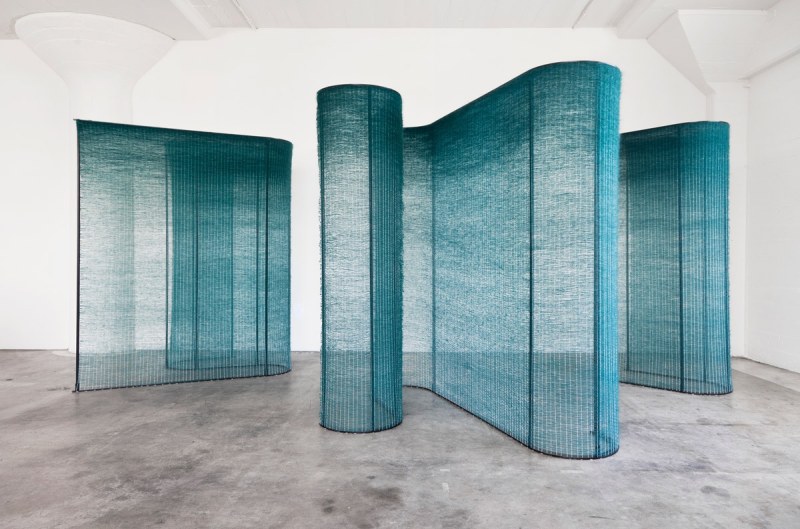Knot for Profit: The Latest in Textile Art
I never left working with this medium, not since 1956,” says fiber artist Sheila Hicks, referring to the sculptures, wall hangings, and installation works made of fiber, fabric, and yarn she has produced throughout her 50-year career. “It doesn’t mean anybody noticed it,” she jokes. “People got distracted with Pop Art, industrial manufacturing, Minimalism. But right now it’s in a surge.”
In 2010, the Addison Gallery of American Art, in Massachusetts held a retrospective titled “Sheila Hicks: 50 Years.” The show secured her position as one of the great modern artists to bring fiber art into the mainstream. Her standing was further cemented by a landmark exhibition held last year at Boston’s Institute of Contemporary Art, “Fiber: Sculpture 1960–present,” featuring works by Hicks and her peers, including Magdalena Abakanowicz and Lenore Tawney. For the 2015 edition of Art Basel, Hicks exhibited in five places, and her work now appears in the collections of MoMA in New York, Centre Georges Pompidou in Paris, and the V&A Museum in London. And this month the 81-year-old legend will present at the New York gallery Sikkema Jenkins & Co. a new iteration of a monumental installation she showed at this past spring’s Art Basel.
Fiber and textile arts are indeed rising in popularity, with a whole new set of designers working in the sector (all crediting Hicks and her contemporaries as inspiration) and interior de-signers evangelizing woven, knit, knotted, and even corded furniture.
One only had to attend May’s Collective Design fair in New York to see the surge in interest that Hicks mentions. There Dana Barnes presented Endolith Casts, a seating system composed of woolen fiber bursting out of cast concrete like lichen. Artist Liz Collins worked with the American Design Club on the 13th iteration of the Knitting Nation project, producing a colorful tapestry of woven bands in real time. Mimi Jung showed her ethereal partitions of fibers woven over powder-coated steel, and Doug Johnston brought his rope-cord pieces. Johnston sees the genre popping up everywhere. In May, he says, “I also noticed many weavings and other fiber works at Frieze, such as work by Brent Wadden and Ruth Laskey.” Plus Polish-born artist Olek wowed fairgoers with ultravivid chairs incorporating crochet, made in collaboration with New York gallery owner Todd Merrill.
Was this critical mass a coincidence or a bold statement on the part of the fair’s organizers? “The designers that showed with us brought another layer to our program and community, and our audience responded incredibly well to their work,” says Collective Design’s founder and director Steven Learner. “The work of Mimi Jung was a standout and the performative aspect to Liz Collins’s work had an interactive quality that was appealing to sight, sound, touch.”
These young practitioners of fabric and textile techniques are riding the wave of success. Jung recently produced pieces for London-based designer Philippe Malouin for a residential project, and Johnston’s works are regularly commissioned through the Patrick Parrish and Matter galleries in New York. And the Obsession chairs by Korean designer Kwangho Lee—who knits over standard furniture pieces with thick cords and wires—captured the eye of Peter Marino, who commissioned works for his recent design of a Dior boutique in SoHo. “We were interested in the way that woven textiles have had a transformative effect on the human psyche through history and tried to incorporate that into our design through the use of woven modern textures,” Marino says.
Architecture has also experienced the surge: In March, legendary German architect Frei Otto, who used lightweight membranes in his edifices, was posthumously named the 2015 Pritzker Prize laureate. In June, Parisian auction house Piasa held its inaugural textile-art sale, signaling that the fervor has reached the secondary art market. The 85 lots on sale, ranging in price from about $1,400 to $40,700, included works by Simone Prouvé, Marga Cuyvers, and Jorge Eielson. Piasa’s head of modern art, Domitille d’Orgeval, says collectors want to “return to an art that doesn’t cheat and [that requires] real know-how.”
With so many touch screens and shiny surfaces surrounding people today, the tac-tility and texture of textile art and design appeal on a fundamental, almost primitive level. “When you’re in front of a computer, what you’re dying to do is touch the knee of the person sitting next to you in a beautiful silk skirt or some guy in a cashmere jacket or a fluffy cotton T-shirt on your way to the coffee machine,” says Hicks about the seductive qualities of plaits, weaves, knots, and stitches as opposed to perfect pixels and polish. “We live in a world where seduction is a principal activity—seducing people to buy, to read, to go somewhere, or acquire something,” Hicks says. And, she asks, What’s the best way to do that? “Color and texture.” The world, it seems, is finally seduced.

